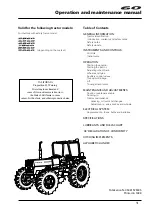
17
OPERATING THE TRACTOR
OPERATING THE TRACTOR
OPERATING NEW TRACTOR
How a new tractor is handled and maintained determines
the life of the tractor.
A new tractor just off the factory production line has been,
of course, tested, but the various parts are not
accustomed to each other, so care should be taken to
operate the tractor for the first 50 hours at a slower speed
and avoid excessive work or operation until the various
parts become "broken-in". The manner in which the
tractor is handled during the "breaking-in" period greatly
affects the life of your tractor.
Therefore, to obtain the maximum performance and the
longest life of the tractor, it is very important to properly
break-in your tractor. In handling a new tractor, the
following precautions should be observed.
B
Do not Operate the Tractor at Full Speed
for the First 50 Hours.
A
Do not start quickly nor apply the brakes suddenly.
A
In winter, operate the tractor after fully warming up the
engine.
A
Do not run the engine at speeds faster than
necessary.
A
On rough roads, slow down to suitable speeds. Do not
operate the tractor at fast speed.
The above precautions are not limited only to new
tractors, but to all tractors. But it should be especially
observed in the case of new tractors.
B
Changing Lubricating Oil for New Tractors
The lubricating oil is especially important in the case of a
new tractor. The various parts are not "broken-in" and are
not accustomed to each other; small metal grit may
develop during the operation of the tractor; and this may
wear out or damage the parts. Therefore, care should be
taken to change the lubricating oil a little earlier than
would ordinarily be required.
For further details of change interval hours.
(See "MAINTENANCE" section.)
STARTING
B
Operator's Seat
To avoid personal injury:
A
Make adjustments to the seat only while the
tractor is stopped.
A
Make sure that the seat is completely secured
after each adjustment.
A
Do not allow any person other than the
operator to ride on the tractor.
C
Travel adjustment
Unlock the travel adjust lever and slide the seat backward
or forward, as required. The seat will lock in position when
the lever is released.
C
Suspension adjustment
Turn the suspension adjust lever to achieve the optimum
suspension setting.
C
Height adjustment
Turn the height adjust knob to desired position while
sitting in the seat.
A
After adjusting the operator's seat, be sure to check to
see that the seat is properly locked,
1. Adjusting the Operator's Position.
(1) Travel adjust lever
(2) Suspension adjust lever
(3) Height adjust knob
(A) "UNLOCK"
(B) "TO INCREASE TENSION"
(C) "TO DECREASE TENSION"
(D) "HIGH"
(E) "LOW"














































